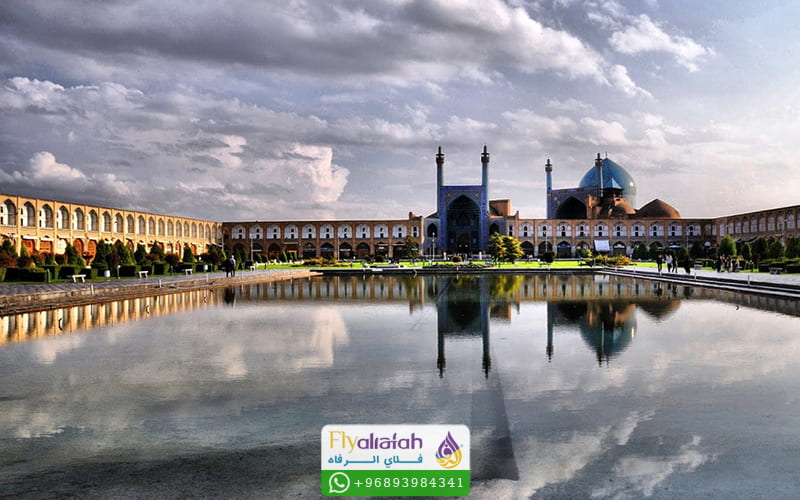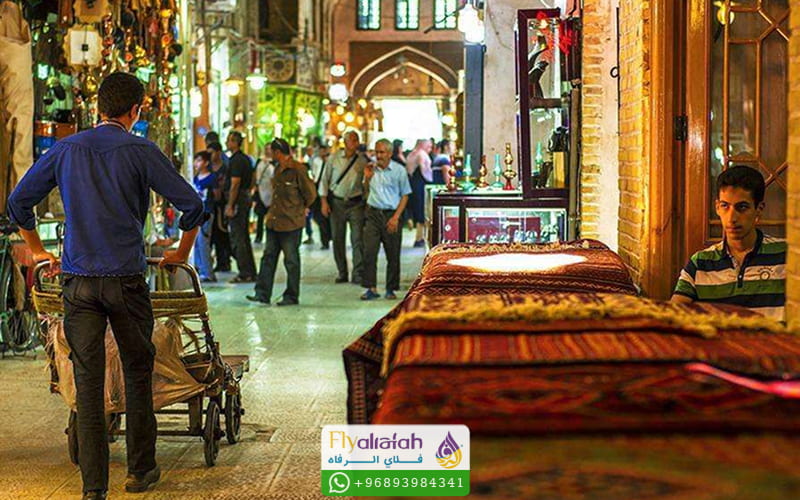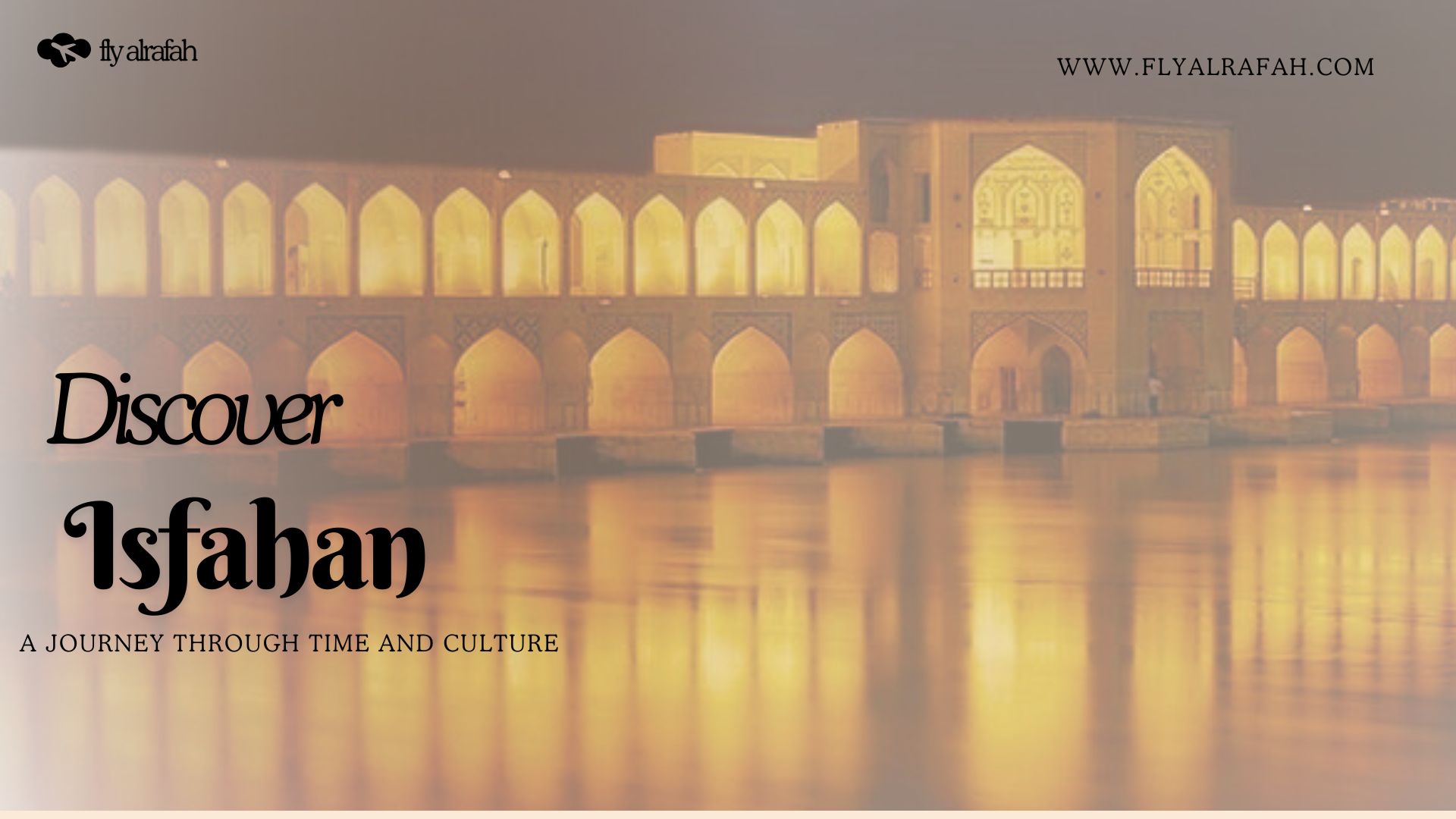Isfahan, often referred to as “Nesf-e Jahan” (Half of the World), is one of Iran’s most beautiful and historically significant cities. Located in central Iran, Isfahan is known for its stunning Islamic architecture, magnificent squares, and vibrant culture. The city has been a cultural and economic hub for centuries, attracting visitors with its rich history and artistic heritage.
table of contents
- Isfahan:-Naqsh-e-Jahan-Square:-A-UNESCO-World-Heritage-Site
- Isfahan:-Historic-Bridges-of-Isfahan
- Isfahan:-Traditional-Crafts-and-the-Grand-Bazaar
- Isfahan:-Gardens-and-Natural-Beauty
- Isfahan:-Cultural-Institutions-and-Museums
- Isfahan:-Culinary-Delights-of-Isfahan
- Isfahan:-A-Perfect-Blend-of-Past-and-Present
Isfahan (IFN): Naqsh-e Jahan Square: A UNESCO World Heritage Site

- Naqsh-e Jahan Square, one of the most famous landmarks of Isfahan, is a UNESCO World Heritage site and a symbol of Persian architectural brilliance. The square is surrounded by remarkable monuments like the Shah Mosque, Sheikh Lotfollah Mosque, and Ali Qapu Palace. These historical structures reflect the artistic and cultural wealth of Iran and make the square a must-visit destination.
- The Shah Mosque stands out with its intricate tilework and grand entrance, showcasing the elegance of Safavid-era architecture. The mosque’s vast courtyard and towering minarets create an awe-inspiring atmosphere that leaves a lasting impression on visitors.
- Sheikh Lotfollah Mosque, on the eastern side of the square, is famous for its unique dome and exquisite interior design. Unlike most mosques, it was built without minarets, adding to its distinct character and serene beauty.
- Ali Qapu Palace, a six-story structure, offers a panoramic view of Naqsh-e Jahan Square from its grand terrace. The palace’s music room, adorned with intricate plasterwork, demonstrates the sophisticated artistic style of the Safavid period.
- The square itself is a lively space where locals and tourists gather, especially in the evenings. The sound of traditional music, the aroma of Persian cuisine, and the sight of horse-drawn carriages create a warm and inviting atmosphere.
- Surrounding the square, the historic Grand Bazaar of Isfahan offers a vibrant shopping experience. Visitors can explore a wide array of traditional crafts, including Persian carpets, miniature paintings, and intricate tile work.
- Naqsh-e Jahan Square is not just a historical site; it’s a cultural and social hub where the spirit of Isfahan comes alive. Its combination of architectural beauty, historical significance, and lively ambiance truly captures the essence of “Half of the World.”
Isfahan (IFN) : Historic Bridges of Isfahan

- Isfahan is home to some of the most iconic and beautiful historic bridges in Iran, each showcasing the city’s architectural brilliance and cultural heritage. These bridges, built primarily during the Safavid era, are not only practical structures but also social and cultural gathering places.
- Si-o-se-pol, or the Bridge of Thirty-Three Arches, is one of the most famous bridges in Isfahan. Spanning the Zayandeh River, this bridge is a masterpiece of Safavid architecture, known for its symmetrical design and stunning reflection on the water. It becomes especially enchanting at night when illuminated, creating a magical atmosphere.
- Khaju Bridge is another remarkable structure, celebrated for its dual function as both a bridge and a dam. Built in the 17th century, the bridge features elaborate tilework and pavilions where Safavid kings once relaxed. Today, it remains a popular spot where people gather to sing traditional songs and enjoy the scenic views.
- The Chubi Bridge, though smaller in scale, also holds historical significance. It was primarily used to irrigate the surrounding gardens and supply water to the royal palaces. Its simple yet elegant design reflects the practical ingenuity of Persian engineers.
- What makes these bridges unique is their role as cultural and social hubs. Locals and tourists often gather on the bridges to enjoy the cool evening air, listen to street musicians, or engage in conversations. The sound of flowing water combined with the laughter and music creates an unforgettable ambiance.
- The architectural style of these bridges is a testament to the artistic vision of the Safavid dynasty. The intricate tilework, symmetrical arches, and thoughtful engineering showcase the fusion of beauty and functionality characteristic of Persian design.
- During the spring and autumn seasons, when the Zayandeh River flows at its fullest, the reflections of the bridges on the water create breathtaking scenes. Photographers and artists often visit these spots to capture the harmony of nature and architecture.
- Beyond their historical and aesthetic value, the bridges of Isfahan symbolize the city’s spirit of community and celebration. They stand as reminders of a time when architecture served not just practical purposes but also fostered cultural interaction and social unity.
Isfahan (IFN): Traditional Crafts and the Grand Bazaar

- The Grand Bazaar of Isfahan is a treasure trove of traditional Persian crafts, offering a glimpse into the city’s rich artistic heritage. As one of the oldest and largest bazaars in Iran, it serves as a vibrant hub where history, culture, and commerce converge.
- Persian carpets are among the most sought-after items in the bazaar, renowned worldwide for their intricate designs and exceptional quality. Each carpet tells a story, with patterns and colors reflecting the cultural identity of the region.
- Miniature painting is another celebrated craft found in the Grand Bazaar. This delicate art form captures detailed scenes from Persian literature and folklore, often painted with incredible precision and vibrant colors.
- Isfahan’s metalwork and enamelware, known as “Minakari,” showcase the city’s expertise in decorative arts. These pieces, adorned with intricate floral and geometric patterns, are often used as ornamental items and cherished souvenirs.
- The art of “Khatamkari,” or Persian marquetry, is also prominently featured. This meticulous craft involves inlaying tiny pieces of wood, bone, and metal to create stunning geometric designs on boxes, frames, and furniture.
- Pottery and ceramics from Isfahan reflect centuries of craftsmanship, with beautifully painted dishes, vases, and tiles that often feature traditional Persian motifs. These items combine functionality with aesthetic appeal.
- The bazaar itself is an architectural wonder, with winding corridors, vaulted ceilings, and historic caravanserais. Walking through its lively alleys, visitors encounter the sounds of artisans at work and the enticing scents of spices and traditional sweets.
- Beyond shopping, the Grand Bazaar offers a cultural experience. Tea houses and cafes provide a space to relax and enjoy local delicacies, while conversations with artisans reveal the passion and skill behind their crafts.
In every corner of the Grand Bazaar, Isfahan’s spirit of creativity and tradition shines through. It remains not only a marketplace but also a living museum of Persian art and culture, inviting visitors to take home a piece of its enduring legacy.
Isfahan (IFN) : Gardens and Natural Beauty
Isfahan is renowned not only for its architectural wonders but also for its lush gardens and stunning natural landscapes. The city’s historical gardens reflect the Persian tradition of creating paradise-like spaces, combining water features, greenery, and elegant design.
One of the most famous gardens in Isfahan is Chehel Sotoun Garden. This UNESCO-listed site features a majestic palace with twenty pillars that reflect beautifully in the garden’s long pool, creating the illusion of forty columns. The surrounding greenery and detailed frescoes inside the palace make this a must-visit location.
Hasht Behesht Garden, known as the “Garden of Eight Paradises,” is another exquisite example of Persian garden design. The garden’s pavilion, adorned with intricate tilework and delicate murals, sits amidst a tranquil setting of trees and fountains.
Bird Garden of Isfahan is a more modern addition, home to over 130 species of birds from around the world. Walking through this lush space offers a refreshing contrast to the city’s historic sites and provides a peaceful escape.
Along the Zayandeh River, parks and green spaces provide locals and tourists with beautiful places for picnics and strolls. The riverbanks are especially lively in the evenings, with families gathering to enjoy the cool air and scenic views.
The natural beauty of Isfahan extends beyond its gardens to the nearby mountains and deserts. Mount Soffeh, a popular hiking destination, offers breathtaking panoramic views of the city and is a perfect spot for outdoor enthusiasts.
Spring and autumn are the best seasons to experience Isfahan’s natural beauty, with blooming flowers and pleasant temperatures enhancing the city’s picturesque charm.
These gardens and natural spaces offer a perfect balance to Isfahan’s historic and cultural attractions, making the city a well-rounded destination for travelers seeking both heritage and tranquility.
Isfahan (IFN) : Cultural Institutions and Museums
Isfahan is a city rich in cultural institutions and museums that preserve and showcase its historical and artistic heritage. The city’s museums offer insights into various aspects of Persian culture, from ancient artifacts to contemporary art.
The Isfahan Museum of Contemporary Art houses an impressive collection of modern Iranian art, reflecting the evolving creativity of the country’s artists. Its exhibitions feature works in diverse media, providing a platform for artistic expression.
The Museum of Decorative Arts displays exquisite examples of Persian craftsmanship, including textiles, ceramics, and metalwork. Each exhibit highlights the intricate designs and fine materials that define Iranian decorative traditions.
The Natural History Museum, located in a historic building, offers a different perspective on Isfahan’s heritage. Its collections of fossils, minerals, and wildlife specimens reveal the region’s ecological diversity.
The Music Museum of Isfahan is a must-visit for music enthusiasts, showcasing traditional Persian instruments and offering live performances. The museum also provides workshops on Iranian musical styles.
The Ali Qapu Palace Museum combines historical architecture with cultural exhibitions, providing insight into Safavid-era art and lifestyle. Its grand halls and detailed frescoes create an immersive experience.
The Chehel Sotoun Museum features artifacts from Isfahan’s golden age, including paintings and manuscripts that capture the city’s cultural vibrancy. The surrounding garden enhances the museum’s serene ambiance.
These cultural institutions not only preserve Isfahan’s artistic legacy but also foster a deeper understanding of Persian history and creativity. Together, they make the city a dynamic center of cultural exploration
Isfahan (IFN): Culinary Delights of Isfahan

Isfahan’s cuisine is a delightful blend of traditional Persian flavors and local specialties. The city’s most famous dish, Beryani, is a must-try for visitors. Made from minced lamb, seasoned with spices, and served on a piece of flatbread, Beryani offers a unique and savory taste.
Fesenjan, a rich and flavorful stew made with pomegranate paste, ground walnuts, and chicken or duck, is another iconic dish of Isfahan. Its perfect balance of sweet and sour flavors makes it a favorite at festive gatherings.
Khoresht-e Mast, a sweet yogurt stew unique to Isfahan, is often served as a dessert. Made with lamb, yogurt, saffron, and rosewater, it offers an unexpected yet delicious combination of flavors.
Gaz, a traditional Persian nougat, is one of Isfahan’s most famous sweets. Made from pistachios, almonds, and rosewater, it’s a popular souvenir for visitors.
The city’s tea houses serve a variety of traditional drinks, including saffron tea and herbal infusions. These drinks provide a perfect complement to Isfahan’s rich culinary offerings.
Street food in Isfahan includes delicious snacks like Ash Reshteh, a hearty noodle soup, and Faludeh, a refreshing frozen dessert made from rice noodles and rosewater syrup.
Local bakeries offer freshly baked bread like Sangak and Barbari, often enjoyed with cheese and fresh herbs for breakfast.
Isfahan’s culinary scene reflects its cultural richness and hospitality, offering flavors that leave a lasting impression on every visitor.
Isfahan (IFN): A Perfect Blend of Past and Present
Isfahan masterfully balances its rich historical legacy with modern development. This perfect blend is evident in the city’s architecture, lifestyle, and cultural institutions. Walking through Isfahan, one can see centuries-old mosques standing beside contemporary cafes, creating a unique and harmonious atmosphere.
The preservation of historical sites like Naqsh-e Jahan Square and the adaptation of traditional houses into boutique hotels show how Isfahan respects its past while embracing modern tourism.
Isfahan’s education and innovation sectors thrive alongside its historical charm. The city hosts prestigious universities and tech startups, fostering an environment where tradition and progress coexist.
Cultural festivals and modern art exhibitions reflect Isfahan’s evolving artistic scene. These events celebrate both classic Persian art and contemporary creativity, attracting diverse audiences.
The city’s transportation system seamlessly connects historic neighborhoods with modern districts, making exploration convenient for visitors.
In Isfahan’s cuisine, traditional dishes like Beryani are served alongside international fare, offering a culinary experience that caters to all tastes.
Local markets sell both age-old handicrafts and modern fashion, showcasing the city’s diverse commercial spirit.
This balance of past and present makes Isfahan a dynamic and inviting destination, where history and modernity coexist beautifully.
Booking Platforms The platform used to book the flight can also influence the price.
 |
Alrafah Travel & Tourism, headquartered in Muscat, Sultanate of Oman, has been operating since 2007. Its expertise lies in launching new round-trip flights from Oman as the origin country to various city airports in Iran, including Shiraz, Tehran, Mashhad, Chabahar, and more. |
So, embark on your journey between Oman and Iran with the assurance that you’ve taken the necessary steps to secure the best possible flight deal. With careful planning and a bit of savvy, you can make your travel dreams a reality without overspending on airfare.
Frequently Asked Questions (FAQ)
Why is Isfahan called “Half of the World”?
Isfahan is called “Half of the World” because of its extraordinary architectural beauty, cultural heritage, and historical significance. During the Safavid era, it was one of the most important and prosperous cities in the world, attracting artists, traders, and scholars from different regions.
2. What makes Naqsh-e Jahan Square a UNESCO World Heritage Site?
Naqsh-e Jahan Square is a UNESCO World Heritage Site due to its stunning Safavid-era architecture and historical importance. Surrounded by iconic landmarks like the Shah Mosque, Sheikh Lotfollah Mosque, and Ali Qapu Palace, the square showcases Persian artistic and cultural brilliance.
3. What are the most famous historic bridges in Isfahan?
The most famous historic bridges in Isfahan include Si-o-se-pol (Bridge of Thirty-Three Arches), Khaju Bridge, and Chubi Bridge. These bridges are celebrated for their architectural elegance and their role as cultural gathering places.
4. What traditional crafts can you find in Isfahan’s Grand Bazaar?
Isfahan’s Grand Bazaar is famous for traditional Persian crafts like Persian carpets, miniature paintings, Minakari (enamelware), Khatamkari (marquetry), and beautifully designed pottery and ceramics.
5. What are some must-try dishes in Isfahan?
Some must-try dishes in Isfahan include Beryani (a unique lamb dish), Fesenjan (a stew with pomegranate paste and walnuts), Khoresht-e Mast (a sweet yogurt stew), and Gaz (a traditional Persian nougat).
6. What role do Isfahan’s historic bridges play today?
Today, Isfahan’s historic bridges serve not only as architectural landmarks but also as social and cultural hubs. Locals and tourists often gather there to enjoy the scenery, listen to street musicians, and experience the lively atmosphere.
7. Why is Isfahan’s architecture so famous?
Isfahan’s architecture is famous for its intricate tilework, grand domes, and elegant arches. Structures like the Shah Mosque, Sheikh Lotfollah Mosque, and Ali Qapu Palace exemplify the sophistication and artistry of Persian design.
8. What makes Isfahan’s gardens unique?
Isfahan’s gardens, like Chehel Sotoun and Hasht Behesht, reflect the traditional Persian garden style, known for their symmetrical layout, flowing water, and lush greenery. These gardens offer a serene escape and showcase the harmony between architecture and nature.










